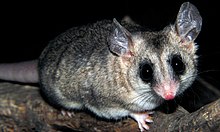| Thylamys Temporal range: Mid Miocene (Colloncuran) to Recent ~14–0 Ma PreꞒ Ꞓ O S D C P T J K Pg N | |
|---|---|

| |
| Elegant fat-tailed mouse opossum | |
| Scientific classification | |
| Domain: | Eukaryota |
| Kingdom: | Animalia |
| Phylum: | Chordata |
| Class: | Mammalia |
| Infraclass: | Marsupialia |
| Order: | Didelphimorphia |
| Family: | Didelphidae |
| Subfamily: | Didelphinae |
| Tribe: | Thylamyini |
| Genus: | Thylamys J. E. Gray, 1843 |
| Type species | |
| Didelphis elegans Waterhouse 1839 | |
| Species | |
|
See text | |
Thylamys is a genus of opossums in the family Didelphidae. The premaxillae are rounded rather than pointed. The females lack a pouch. The females' nipples are arranged in two symmetrical rows on the abdomen. All species but T. macrurus store fat in their tails., although this is not necessarily true for all species in the genus. Fossils belonging to the genus date back to the Miocene, with the oldest specimens being found in the Cerro Azul Formation of Argentina and the Honda Group of Colombia. Genetic studies indicate that the genus may have originated around 14 million years ago.
Taxonomy
Cladogram of living Thylamys species.
| |||||||||||||||||||||||||||||||||||||||||||||||||||||||||||||||||||
Other species of Thylamys.
- †T. colombianus Goin 1997
- T. fenestrae (Marelli 1932)
- †T. minutus Goin 1997
- †T. pinei Goin, Montalvo & Visconti 2000
- †T. zettii Goin 1997
References
- Gardner, A.L. (2005). "Order Didelphimorphia". In Wilson, D.E.; Reeder, D.M (eds.). Mammal Species of the World: A Taxonomic and Geographic Reference (3rd ed.). Johns Hopkins University Press. pp. 17–18. ISBN 978-0-8018-8221-0. OCLC 62265494.
- Eisenberg, John Frederick; Redford, Kent Hubbard (1999). Mammals of the Neotropics: The Central Neotropics: Ecuador, Peru, Bolivia, Brazil. University of Chicago Press. p. 624. ISBN 978-0-226-19542-1.
- Gardner, Alfred L. (2008). Mammals of South America: Marsupials, xenarthrans, shrews, and bats. University of Chicago Press. p. 669. ISBN 978-0-226-28240-4.
- Voss, R.S. & Jansa, S.A. (2003). "Nonmolecular data and new IRBP sequences: separate and combined analyses of didelphine relationships with denser taxon sampling". Bulletin of the American Museum of Natural History. 276: 1–82. doi:10.1206/0003-0090(2003)276<0001:PSODMI>2.0.CO;2. hdl:2246/444. S2CID 55193165.
- Braun, J.K.; et al. (2005). "Phylogenetic and biogeographic relationships of mouse opossums Thylamys (Didelphimorphia, Didelphidae) in southern South America". Journal of Mammalogy. 86 (1): 147–159. doi:10.1644/1545-1542(2005)086<0147:PABROM>2.0.CO;2.
- Steiner, C.; et al. (2005). "New DNA data from transthyretin nuclear intron suggest an Oligocene to Miocene diversification of living South American opossums (Marsupialia: Didelphidae)". Molecular Phylogenetics and Evolution. 35 (2): 363–379. Bibcode:2005MolPE..35..363S. doi:10.1016/j.ympev.2004.12.013. PMID 15804409.
- Upham, Nathan S.; Esselstyn, Jacob A.; Jetz, Walter (2019). "Inferring the mammal tree: Species-level sets of phylogenies for questions in ecology, evolution and conservation". PLOS Biol. 17 (12): e3000494. doi:10.1371/journal.pbio.3000494. PMC 6892540. PMID 31800571.
- Amador, Lucila I.; Giannini, Norberto P. (2016). "Phylogeny and evolution of body mass in didelphid marsupials (Marsupialia: Didelphimorphia: Didelphidae)". Organisms Diversity & Evolution. 16 (3): 641–657. doi:10.1007/s13127-015-0259-x. hdl:11336/50679. S2CID 17393886.
- Flores, D.; Teta, P. (2016). "Thylamys citellus". IUCN Red List of Threatened Species. 2016: e.T199835A22172943. doi:10.2305/IUCN.UK.2016-2.RLTS.T199835A22172943.en. Retrieved 9 January 2020.
- Flores, D.; Teta, P. (2016). "Thylamys pulchellus". IUCN Red List of Threatened Species. 2016: e.T199834A22172571. doi:10.2305/IUCN.UK.2016-2.RLTS.T199834A22172571.en. Retrieved 9 January 2020.
- Thylamys at Fossilworks.org
- Martin, G.M.; Flores, D. (2016). "Thylamys fenestrae". IUCN Red List of Threatened Species. 2016: e.T199836A22172852. doi:10.2305/IUCN.UK.2016-2.RLTS.T199836A22172852.en. Retrieved 9 January 2020.
| Taxon identifiers | |
|---|---|
| Thylamys | |
This article about a marsupial is a stub. You can help Misplaced Pages by expanding it. |